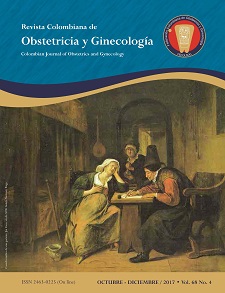Characterisation of maternal mortality in Colombian indigenous communities, 2011 to 2013. Study of the surveillance epidemiological records of sentinel cases
DOI:
https://doi.org/10.18597/rcog.2925Keywords:
Maternal mortality, indigenous population, eclampsia, postpartum haemorrhage, puerperal infectionAbstract
Objective: To characterise the behaviour of maternal mortality (MM) in Colombian indigenous populations during the triennium 2011-2013.
Materials and methods: Study based on epidemiological surveillance of maternal mortality cases. The study population included all maternal deaths, direct and indirect, and live births reported in the indigenous population in the country. Cases of mortality coinciding with pregnancy, such as deaths due to injuries from external causes, accidental and incidental causes, were excluded. The search of MM sentinel cases was made in the databases of the National Public Health Surveillance System (SIVIGILA) from the National Health Institute (INS), and registries of births and deaths of the National Administrative Statistics Department (DANE) for the time period between 2011 and 2013. Sociodemographic variables, maternal and childbirth care variables, geographical area and place of death, and grouped and specific causes of maternal death were measured. A descriptive analysis of the information was carried out using absolute and relative frequency measurements for the data.
Results: In Colombia, 1546 cases of deaths in pregnant women were reported during the triennium 2011-2013, of which 143 cases of MM were analysed in indigenous communities: 130 met the inclusion criteria and 13 were excluded due to incidental or accidental causes. The maternal mortality ratio (MMR) for this population was 327.5 per 100,000 live births during the triennium, while in the non-indigenous population it was 60.9. Of maternal deaths in indigenous population, 22.3% were in girls under 19 years of age and 29.2% in women over 35 years of age. The main causes of MM were postpartum haemorrhage, eclampsia and puerperal sepsis.
Conclusion: In indigenous communities, maternal mortality is five times greater than in the non-indigenous population of the country. Multisectorial interventions that take into consideration the cultures of these peoples are needed in order to reduce inequities that affect them.
Author Biographies
Laura Margarita Bello-Álvarez, Universidad Nacional de Colombia
Médica con Énfasis en Salud Pública, Universidad de La Sabana; MSc(e) Public Health, University of London – London School of Hygiene and Tropical Medicine; Especialista en Obstetricia y Ginecología, Universidad
Nacional de Colombia. Cali, Colombia. lmbelloa@unal.edu.co
Arturo José Parada Baños, Universidad Nacional de Colombia
Especialista en Obstetricia y Ginecología, Universidad Nacional
de Colombia. Profesor Asociado, Departamento de Obstetricia y
Ginecología, Facultad de Medicina, Universidad Nacional de Colombia. Bogotá, Colombia. ajparadab@unal.edu.co
References
World Health Organization. International Classification of diseases. Manual of the international statiscal classification of diseases, injuries and causes of death. 10 ed. Geneva: WHO; 2010 [visitado 2017 Feb 10]. Disponible en: www.who.int/classifications/icd/ICD10Volume2_en_2010.pdf
Parada AJ. Mortalidad materna. En Obstetricia integral siglo XXI, tomo I. Capítulo 23. Bogotá: Universidad Nacional de Colombia [visitado 2017 Feb 14]. Disponible en: http://www.bdigital.unal.edu.co/1563
Michael Gracey MK. Indigenous health part 1: Determinants and disease patterns. The Lancet. 2009:65-75. https://doi.org/10.1016/S0140-6736(09)60914-4
Programa de las Naciones Unidas para el Desarrollo (PNUD). Objetivos de desarrollo del milenio. Informe 2015. Bogotá: PNUD; 2015 [visitado 2017 Feb 12]. Disponible en: www.co.undp.org/content/dam/colombia/docs/.../undp-co-odsinformedoc-2015.pdf
Organización Panamericana de la Salud. Salud de las Américas. Determinantes Sociales de la Salud en la Región de las Américas [visitado 2017 Oct 15]. Disponible en: http://www.paho.org/salud-en-las-americas-2017/?post_type=post_t_es&p=310&lang=es
Instituto Nacional de Salud de Colombia. Informe del evento Mortalidad Materna, periodo epidemiológico XIII de 2014. Bogotá, 2014 [visitado 2017 Mar 13]. Disponible en: http://www.ins.gov.co/lineas-deaccion/Subdireccion-Vigilancia/Paginas/informes-deevento.aspx
Ministerio de Salud y Protección Social de Colombia. Perfil de Salud de la Población Indígena, y medición de desigualdades en salud. Colombia 2016. Bogotá. 2016 [visitado 2017 Feb 14]. Disponible en: https://www.minsalud.gov.co/sites/.../Perfil-salud-pueblosindigenas-colombia-2016.pdf
Instituto Nacional de Salud de Colombia (INS). Informe final del evento mortalidad materna año 2013. Bogotá. 2014 [visitado 2017 Feb 15]. Disponible en: www.ins.gov.co/lineas-de-accion/ons/SiteAssets/Paginas/.../informe-final%20ONS.pdf
Whitehead M. The concepts and principles of equity and health. Copenhagen: World Health Organization Regional Office for Europe; 2000.
Comisión Nacional para el desarrollo de los pueblos indígenas de México. La mortalidad materna indígena y su prevención. México: PNUD; 2010 [visitado 2017 Feb 5]. Disponible en: www.cdi.gob.mx/embarazo/mortalidad_materna_indigena_prevencion_cdi_pnud.pdf.
Comisión Económica para América Latina y el Caribe (CEPAL). Salud materno infantil de pueblos indígenas y afrodescendientes de América Latina: una relectura desde el enfoque de derechos. Santiago de Chile: Naciones Unidas; 2010 [visitado 2017 Feb 10]. Disponible en: http://www.cepal.org/cgi- bin/getProd.asp?xml=/publicaciones/xml/8/41668/P41668.xml&xsl=/celade/tpl/p9f.xsl&base=/ celade/tpl/topbottom_ind.xslt
Trygve O. Arriesgar la vida por dar a luz en los bosques tropicales de Panamá. La salud materna entre el pueblo Ngobe. Nueva York: United Nations Population Fund (UNFPA). 2007 [visitado 2017 Oct 10]. Disponible en: http://www.unfpa.org/news/news.cfm?ID=949&Language=2.
Bristol N. Dying to give birth: Fighting maternal mortality in Peru. Health Aff (Millwood). 2009;28:997-1002 [visitado 2017 Oct 10]. Disponible en: http://content.healthaffairs.org/cgi/content/full/28/4/997.
Arias-Valencia MM. Comportamiento reproductivo en las etnias de Antioquia – Colombia. Salud pública Méx. 2001;43:268-78 [visitado 2017 Feb 10]. Disponible en: http://www.scielo.org.mx/scielo.php?script=sci_arttext&pid=S0036-36342001000400003
Posso JL. Las transformaciones del significado y la vivencia de la maternidad en mujeres negras, indígenas y mestizas del suroccidente colombiano. Sociedad y economía. 2010;18:59-84 [visitado 2017 Feb 11]. Disponible en: www.redalyc.org/pdf/996/99618003003.pdf.
Ministerio de Salud y Protección Social de Colombia. Análisis de situación de salud (ASIS) Colombia, 2015. Dirección de Epidemiología y Demografía. MinSalud. Bogotá. 2015 [visitado 2017 Feb 14]. Disponible en: https://www.minsalud.gov.co/sites/rid/Lists/BibliotecaDigital/ RIDE/VS/.../asis-2015.pdf.
Say L, Chou D, Gemmill A, Tunçalp Ö, Moller AB, Daniels J, et al. Global causes of maternal death: A WHO systematic analysis. The Lancet Global Health. 2014;2:e323-e33. https://doi.org/10.1016/S2214-109X(14)70227-X
How to Cite
Downloads
Downloads
Published
Issue
Section
| Article metrics | |
|---|---|
| Abstract views | |
| Galley vies | |
| PDF Views | |
| HTML views | |
| Other views | |
















